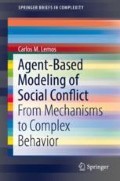Abstract
This chapter contains a description of the proposed agent-based model, using the well-known “Overview, Design Concepts and Details” protocol. The model was implemented in NetLogo and is based on the same two types of agents—citizens and law-enforcement—as in Epstein’s model, but “citizen” agents have one subtype (“activist”) used for implementing network influence effects. The salient aspects of the model description are centered on the submodels for the risk perception, the expression of hardship in terms of value-sensitive relative deprivation, endogenous legitimacy feedback and network influence effects, which provide extensions to Epstein’s model. The model includes two networks called group and infl (for “influentials”), to represent two different types of social influence (due to small and highly cohesive groups or “activists,” respectively). Network influences were implemented using a form of dispositional contagion. The chapter also includes an outline of the R scripts for pre- and post-processing the model results, using the RNetLogo package.
Access this chapter
Tax calculation will be finalised at checkout
Purchases are for personal use only
Notes
- 1.
A cell is considered empty if there is no agent inside it, or if it contains only jailed “citizen” agents. In the NetLogo implementation, “jailed” agents are hidden from view and do not interfere with the other agents’ movement, but cannot be removed from the model space.
- 2.
The theoretical concepts on agenda setting can be found in [8].
- 3.
This speeds up the calculations because the numbers of “active,” “jailed,” and “quiet” agents are used more than once.
- 4.
The scale parameter x m is the minimum possible value/level of welfare, e.g. the minimum national income. The shape parameter determines the inequality of value. It is necessary that α > 1 for finite mean value and variance of the distribution defined by equation (5.3).
- 5.
This value of x m is chosen so that the median of the distribution of value is 1/2, which is equal to the mean value of \(H \sim \mathcal{ U}(0, 1)\).
- 6.
In the present work social RD is not considered, because ethnic, religious or other conflicts related to identity are not modeled.
- 7.
This allows the exact reproducibility of the simulations, if required at a later time.
References
T.A. Birkland, An Introduction to the Policy Process: Theories, Concepts, and Models of Public Policy Making, 3rd edn. (Routledge, Abingdon, 2015)
D. Bischof, Why Arabs Rebel - Relative Deprivation Revisited. Master’s thesis, Fakultät Sozial und Wirtschaftswissenschaften der Otto-Friedrich-Universität Bamberg, 2012
J.M. Epstein, Agent_Zero. Toward Neurocognitive Foundations for Generative Social Science (Princeton University Press, Princeton, 2013)
M. Fonoberova, V.A. Fonoberov, I. Mezic, J. Mezic, P. Jeffrey Brantingham, Nonlinear dynamics of crime and violence in urban settings. J. Artif. Soc. Soc. Simul. 15(1), (2012)
Freedom House, Freedom in the World, Individual Country Ratings and Status. https://freedomhouse.org/report-types/freedom-world, 2015. Accessed 2015-07-13
B. Gilley, The meaning and measure of state legitimacy: Results for 72 countries. Eur. J. Polit. Sci. 45, 499–525 (2006)
B. Gilley, The Right to Rule. How States Win and Lose Legitimacy (Columbia University Press, New York, 2009)
V. Grimm, U. Bergern, D.L. DeAngelis, J. Gary Polhill, J. Giskee, S.F. Railsback, The ODD protocol: A review and first update. Ecol. Model. 221(221), 2760–2768 (2010)
T.R. Gurr, Psychological factors in civil violence. World Politics 20(2), 245–278 (1968)
B. Milanovic, All the GINIS Dataset, 2014. Accessed 2016-03-28
M.E.J. Newman, Power laws, Pareto distribution and Zipf’s law. Contemp. Phys. 46(5), 323–351 (September-October 2005)
G. Sharp, From Dictatorship to Democracy, 4th edn. (The Albert Einstein Institution, Boston, 2010)
The Fund for Peace, Fragile States Index. http://fsi.fundforpeace.org/data, 2015. Accessed 2015-11-09
The Robert S. Strauss Center, Social Conflict Analysis Database. https://www.strausscenter.org/scad.html, 2015. Accessed 2015-07-25
J.C. Thiele, R Marries NetLogo: introduction to the RNetLogo package. J. Stat. Software 58(2), 1–41 (2014)
J.C. Thiele, W. Kurth, V. Grimm, RNetLogo: An R package for running and exploring individual-based models implemented in NetLogo. Methods Ecol. Evol. 3(3), 480–483 (2012)
U. Wilensky, NetLogo. Center for Connected Learning and Computer-Based Modelling (Northwestern University, Evanston, IL, 1999)
U. Wilensky, NetLogo Rebellion Model (Northwestern University, Evanston, IL, 2004)
Author information
Authors and Affiliations
Rights and permissions
Copyright information
© 2018 The Author(s)
About this chapter
Cite this chapter
Lemos, C.M. (2018). ABM of Civil Violence: ODD Description. In: Agent-Based Modeling of Social Conflict. SpringerBriefs in Complexity. Springer, Cham. https://doi.org/10.1007/978-3-319-67050-8_5
Download citation
DOI: https://doi.org/10.1007/978-3-319-67050-8_5
Published:
Publisher Name: Springer, Cham
Print ISBN: 978-3-319-67049-2
Online ISBN: 978-3-319-67050-8
eBook Packages: Social SciencesSocial Sciences (R0)

